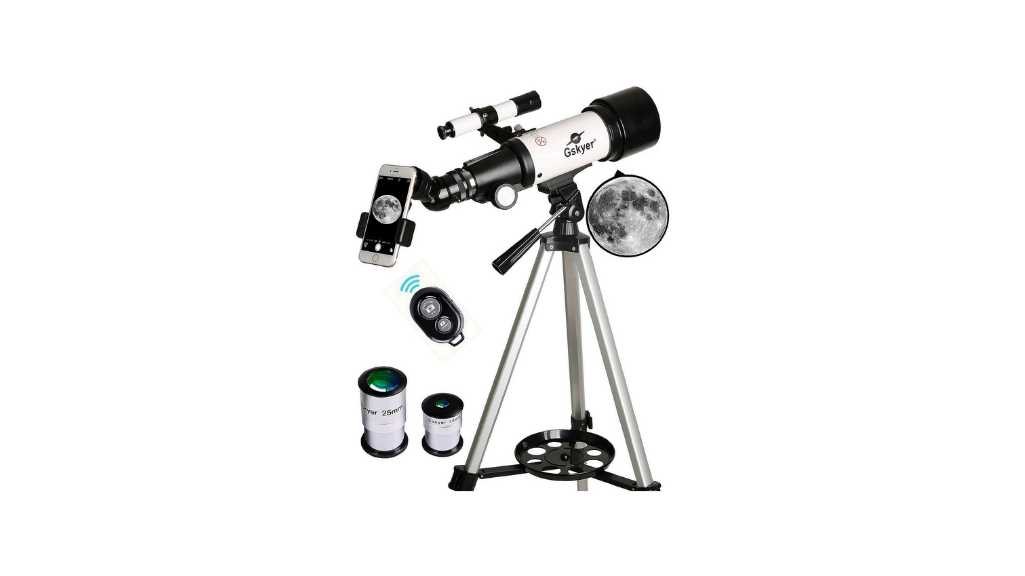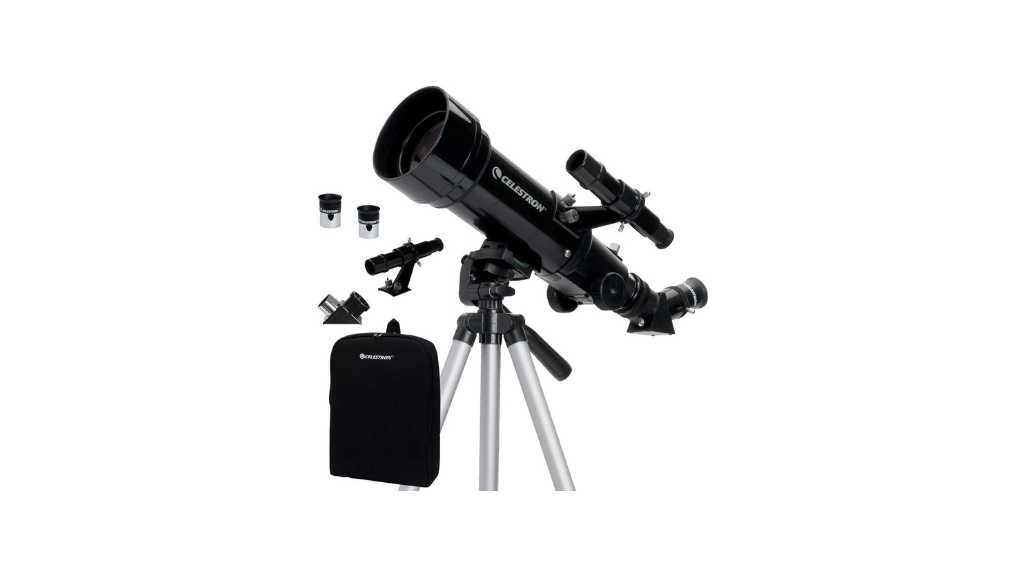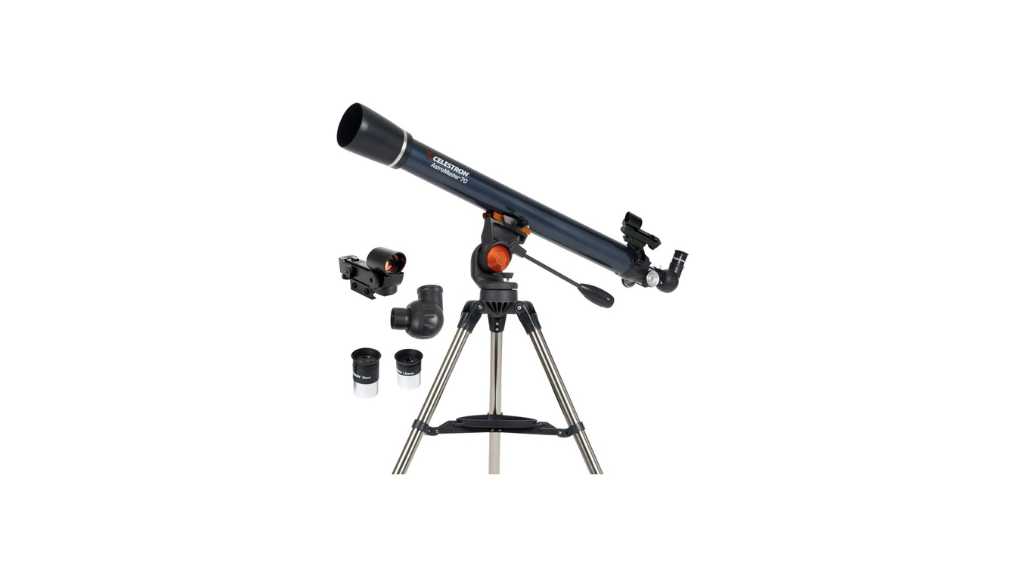Embark on a celestial journey with our top-tier telescope, crafted to unveil the mysteries of the cosmos. Designed for both novice stargazers and seasoned astronomers, its cutting-edge optics deliver unparalleled clarity, revealing distant galaxies and nebulae with breathtaking detail. Explore the wonders of the universe from the comfort of your own backyard with this exceptional instrument.
JLHT 40X60 Monocular Telescope

Elevate your outdoor adventures with the JLHT 40X60 Monocular Telescope. With 10X magnification and a 60mm objective lens diameter, this monocular delivers vivid imagery across diverse landscapes, from hiking trails to stadium seats. Its BAK-4 prism and fully multi-coated lens ensure high contrast, sharp clarity, and wide fields of view, capturing every detail with precision. Plus, its compact, waterproof, and fog-proof design guarantees durability in challenging weather conditions, allowing you to explore with confidence.
Pairing seamlessly with smartphones, this monocular enables instant sharing of HD images, thanks to its quick alignment holder and remote control functionality. Whether you’re birdwatching or attending concerts, this versatile device enriches your experiences and creates lasting memories. With our 30-day money-back guarantee, immerse yourself in the world of JLHT and redefine your perspective today!
Pros:
- 10X magnification for detailed viewing
- 60mm objective lens for bright and clear images
- BAK4 prism and fully multi-coated lens for high contrast
- Waterproof and fog-proof design for durability in various weather conditions
- Smartphone compatibility with quick alignment holder and remote control
- Compact and sturdy, suitable for outdoor activities
- It comes with a tripod for added stability
- Manual focus and reflex finderscope for versatility
Cons:
- Weighs 14 ounces and may be considered slightly heavier by some users.
Gskyer Telescope

Embark on a celestial journey with the Gskyer Telescope, featuring a 400mm focal length and 70mm aperture for stunning views of stars and the moon. Fully coated optic glass lenses ensure high transmission, protecting your eyes while delivering breathtaking images. With two replaceable eyepieces and a 3x Barlow lens, magnification is tripled, while a 5×24 finder scope with cross-hair lines simplifies object location.
Explore effortlessly with a wireless camera remote and smartphone adapter, capturing celestial wonders on screen. The adjustable aluminum alloy tripod and carry bag facilitate various viewing positions and easy transportation. Backed by a two-year warranty and 24-hour technical support, satisfaction is guaranteed in your astronomical pursuits.
Pros:
- Quality optics with fully coated glass lenses
- Versatile magnification with replaceable eyepieces and 3x Barlow lens
- Wireless remote and smartphone adapter for easy celestial photography
- Adjustable aluminum alloy tripod for various viewing positions
- Portable design with a carry bag for convenient travel and storage
- TWO-YEAR warranty and 24-hour technical support
Cons:
- Manual focus may require more precise adjustments
- Altazimuth Mount may have a learning curve for beginners
- Limited to astronomical observations, not suitable for terrestrial use
Celestron – Portable Refractor Telescope

Discover the Celestron Portable Refractor Telescope, boasting superior optics with fully-coated glass for unparalleled clarity. With an ample 70mm objective lens, it offers brighter views without added bulk. Equipped with two high-quality eyepieces, delve into celestial wonders or observe terrestrial landscapes with ease. Setup is a breeze with the lightweight frame and included backpack, perfect for on-the-go stargazing adventures. Plus, enjoy a bonus tripod and software for comprehensive astronomical exploration. Backed by a two-year warranty and US-based customer support, trust in Celestron’s legacy of quality since 1960.
Pros:
- Superior optics with fully-coated glass
- Potent 70mm objective lens for detailed views
- Two high-quality eyepieces (20mm and 10mm)
- Portable design with a custom backpack
- Easy setup with full-height tripod
- Bonus accessories included
- FREE download of top-rated astronomy software
- 2-Year US Warranty and unlimited US-based support
Cons:
- Manual focus may require adjustment for precise viewing
- Reflex Finderscope may have a learning curve for beginners
Celestron – Refractor Telescope

Elevate your stargazing experience with the Celestron Refractor Telescope. With a 70-millimeter objective lens diameter and a focal length of 914 millimeters, this telescope offers crisp, detailed views of celestial wonders. Its quick and easy no-tool setup gets you observing in no time, while the permanently mounted StarPointerTM red dot finderscope ensures precise alignment for effortless navigation through the night sky.
Ideal for both terrestrial and astronomical use, this telescope features erect image optics and a pan-handle Alt-Az control with clutch for smooth, accurate pointing. Whether you’re exploring distant galaxies or observing wildlife, the Celestron Refractor Telescope delivers stunning views with ease.
Pros:
- Powerful 70mm glass optic objective lens
- Fully coated optics for clear and detailed views
- Sturdy yet lightweight frame for portability
- Quick and easy setup with no tools required
- Alt-Az control for smooth and accurate pointing
- It comes with essential accessories: eyepieces, star diagonal, and red dot finderscope
- Free download of a top-rated astronomy software program
- 2-Year US Warranty and unlimited support from Celestron’s US-based experts
Cons:
- It weighs 18 pounds and may be relatively heavy for some users
OYS Store Telescope

Embark on a celestial journey with the OYS Store Telescope. With a 70mm aperture and 400mm focal length, it delivers breathtaking images with enhanced clarity and brightness. Equipped with two eyepieces for 20X and 44X magnification, alongside a 5×24 finder scope, locating celestial objects becomes a breeze. Plus, its diagonal prism ensures you see images in their correct orientation, making it perfect for both sky and land observation.
Portable and easy to set up, this telescope comes with a phone adapter, allowing you to capture and share mesmerizing views with loved ones. Its lightweight design, complete with an adjustable tripod and custom backpack, makes it the ideal travel companion. Gift this telescope to aspiring astronomers and ignite their passion for exploring the cosmos, fostering a love for science and nature.
Pros:
- 70mm aperture, 400mm focal length for vivid images
- Versatile magnification (20X and 44X) with two eyepieces
- Portable, quick setup with adjustable tripod and backpack
- Phone adapter for easy image capture and sharing
- Lifetime warranty and responsive 24-hour customer service
Cons:
- Manual focus may require adjustment
- Altazimuth mounts are less stable than equatorial
- Not suitable for advanced astrophotography
- The 5×24 finder scope is relatively small for larger models.
Best Telescope Buying Guide
Investing in a telescope can be an exciting and rewarding experience, allowing you to explore the wonders of the night sky and delve into the depths of the cosmos. However, choosing the right telescope can be a daunting task, especially with the vast array of options available in the market. This detailed buying guide aims to provide you with the essential information you need to make an informed decision.
Understanding Telescope Types
Refractor Telescopes
Refractor telescopes are known for their simplicity and versatility. They use a lens to gather and focus light, making them ideal for observing planets, the Moon, and bright celestial objects. These telescopes are typically low-maintenance and provide high-quality images.
Reflector Telescopes
Reflector telescopes, on the other hand, employ mirrors to collect and focus light. They are generally more affordable than refractors and offer a larger aperture (the diameter of the primary mirror) for their size, making them excellent for deep-sky observations such as galaxies and nebulae.
Compound Telescopes (Catadioptric)
Compound telescopes, also known as catadioptric telescopes, combine both lenses and mirrors in their design. They offer a compact size while providing a large aperture, making them a popular choice for amateur astronomers who want a balance between portability and performance.
Aperture: The Key to Clarity
The aperture, or the diameter of the primary light-gathering component (lens or mirror), plays a crucial role in determining the telescope’s performance. A larger aperture allows more light to enter the telescope, resulting in brighter and sharper images. However, larger apertures also come with increased weight and cost.
Mounting and Stability
A stable and smooth mounting system is essential for enjoying a satisfying viewing experience. Equatorial mounts are designed to follow the movement of celestial objects across the sky, while alt-azimuth mounts provide a simpler and more user-friendly operation.
Eyepieces and Accessories
Different eyepieces offer varying magnification levels and fields of view, enabling you to observe celestial objects in greater detail or capture a wider perspective. Additional accessories, such as filters, eyepiece cases, and star charts, can enhance your observing experience and broaden your astronomical knowledge.
Portability and Ease of Use
Consider your intended usage and location when selecting a telescope. If you plan to observe from different locations, a lightweight and portable telescope may be more suitable. On the other hand, if you have a dedicated observing site, a more substantial telescope could provide superior performance.
Conclusion
Choosing the best telescope involves considering your specific needs, observing goals, and budget. By understanding the different types of telescopes, their key features, and the necessary accessories, you can make an informed decision that aligns with your astronomical aspirations. Remember, the best telescope is the one that not only meets your requirements but also ignites your passion for exploring the vastness of the cosmos.
Frequently Asked Question
What is the best type of telescope for beginners?
For beginners, a good choice is a refractor telescope. They are easy to use, require little maintenance, and provide clear views of celestial objects like the moon and planets.
What features should I consider when buying a telescope?
When purchasing a telescope, consider aperture size, focal length, portability, and ease of setup. Aperture size determines light-gathering ability, while focal length affects magnification. Portability is essential if you plan to travel with your telescope, and easy setup ensures you can start observing quickly.
Is a computerized or manual telescope better for a beginner?
Both manual and computerized telescopes have their advantages. Manual telescopes are typically simpler and cheaper, making them great for learning the basics of stargazing. Computerized telescopes, on the other hand, can automatically locate and track celestial objects, which can be helpful for beginners navigating the night sky.
What is the difference between a reflector and a refractor telescope?
Reflector telescopes use mirrors to gather and focus light, while refractor telescopes use lenses. Reflectors are generally better for observing faint deep-sky objects due to their larger apertures, while refractors provide sharper images of planets and the moon.
What is the best telescope for astrophotography?
The best telescope for astrophotography depends on your specific needs and budget. However, many astrophotographers prefer reflector telescopes with a large aperture and a sturdy equatorial mount for tracking celestial objects accurately during long-exposure photography sessions.

Ross Walters, an Electrical supplies and Water Appliances specialist, shares his extensive expertise on top platforms. With a focus on empowering professionals and enthusiasts, Ross delivers up-to-date insights and practical advice. His commitment to staying abreast of industry trends establishes him as a trusted source for navigating the complexities of electrical systems and water appliances.





